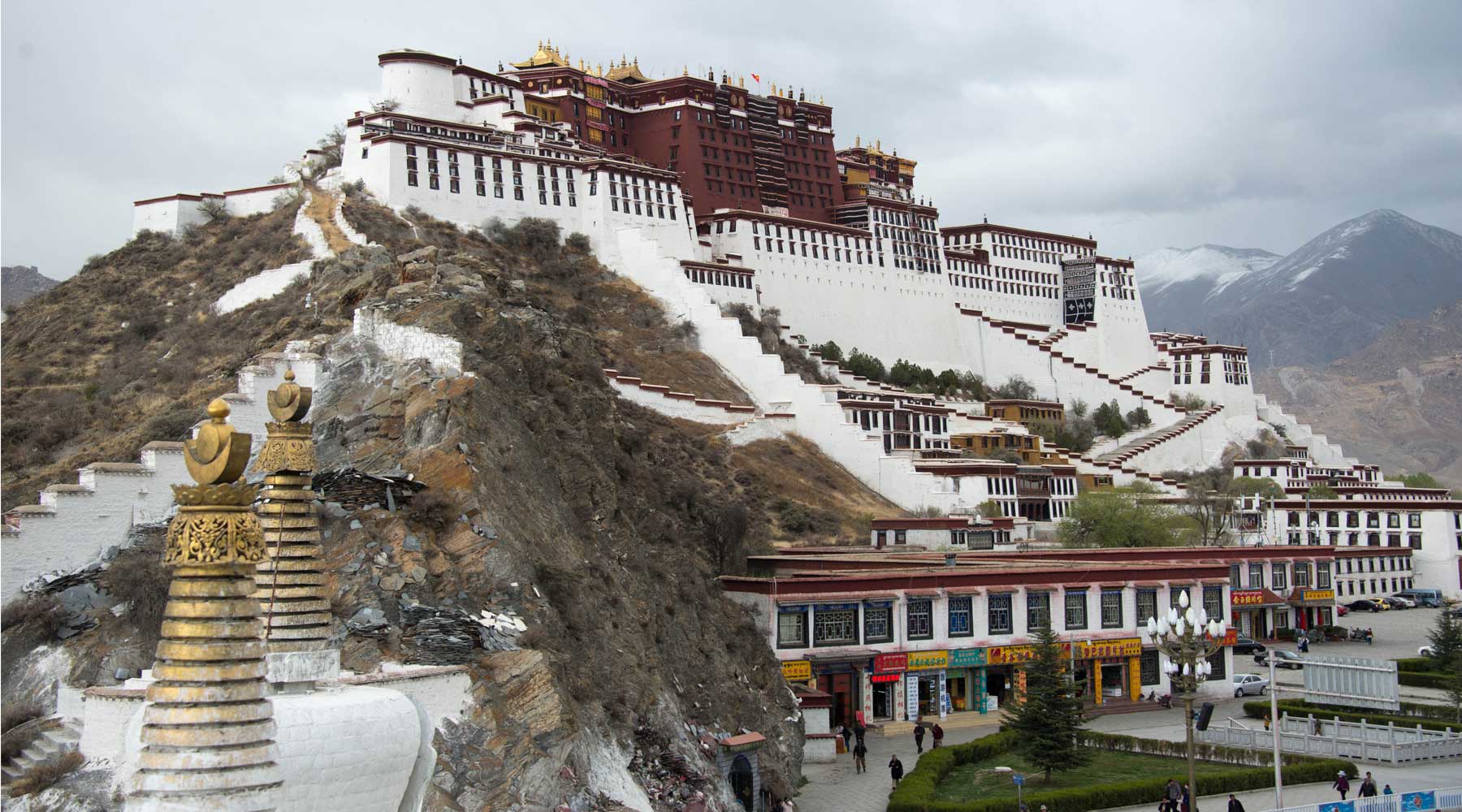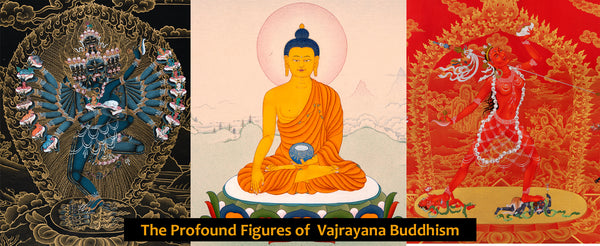How was Buddhism Introduced to Tibet?
The light of Buddhism surfaced Tibet for the first time during the reign of Lhathothori Nyantsan, the 28th King of the Yarlung dynasty. According to Shakapa, the Kings period is between 173-293 CE. The initiation of spreading Buddhism started with presenting ‘Do sde pang kong phyag rgya pa’ and others Buddhist scriptures by Pandita Losemtsho and Lotsawa Lithes to the King.
Since no one could read the text, it was kept safe and given the name ‘gNyan po gsang ba’ which meant strict or sacred secret.
The King revered and held the texts in high regard; as a result, he was claimed to have lived for 120 years. He was said to have a dream where he saw that the writing would be deciphered after five generations.
Srongtsan Gampo, 33rd King of Tibet, had a significant role in the development of Tibet. It was during his rule that Tibet became a powerful, cohesive country with effective diplomatic ties to its neighbors.
A wise minister named Thonmi Sambhota is supposed to have changed or created the Tibetan alphabet, consisting of thirty consonants and four vowels, after being dispatched to India to study the Indian writing system. Several Buddhist scriptures, including the ‘gNyan po gsang ba’, were translated into Tibetan.
With Nepal, Zhangzhung, Minyag (Tangut), and China, the Tibetan ruler made matrimonial partnerships. The queens from these different kingdoms made significant contributions to the development of Tibetan civilization and culture. Balsa and Gyasa, two queens from China and Nepal, respectively, each brought a scared Buddha statue with them. Each Buddha statue had its temple established for it; Rasa Trulnang and Ramoche are still highly regarded in Tibet.
The Tibetan ruler traveled to Waitushan, China's five-peaked mountain, in 645 CE. Within this area, he constructed 108 temples as well as other parts of the country. As a result, Buddhism flourished in the land of Tibet.
Source: Green Tara and White Tara
Later, it was said that the Nepalese queens were Green and White Tara, and that the King was an embodiment of Avalokiteshvara, the Buddha of Compassion.
Era of King Trisrong Deutsan:
Buddhism further grew and became more established during the reigns of the 38th king Trisrong Deutsan (742–797) CE and the 42nd king Tri Ralpachan (801–841 CE).
Abbot Shantarakshita, an Indian saint was invited to Tibet to teach Buddhism during the reign of King Trisong Deutsan. Shantarakshita advised inviting Guru Padmasambhava from the realm of Orgyan to appease the local guardian spirits and hasten the successful development of Buddhism in Tibet. There he discovered the strength of the local Bon deities was too great to proceed. Accepting the invitation Guru Padmasambhava subdued the local guardian spirit to defend Tibet's Buddhism.
In the royal court of King Trisong Deutsan, both Guru Padmasambhava and Shantarakshita initiated the Buddhist discourse and unlocked the Tibetan door to Indian Buddhist teachings. Following the first seven Tibetan monks' outstanding graduation, several Indian saints traveled to Tibet. Under royal sponsorship, a considerable deal of Sanskrit Buddhist literature were passionately translated into the Tibetan language. The enormous Samye Monastery in Tibet was constructed under the direction of Shantarakshita. His design was based on the universe conceived of by the Buddhists.
Buddhism gradually brought the belligerent Tibetans to a state of calm. The royal choice was guided by Buddhist teachings, which also took on the role of the public's guide to ethics and moral principles. Religious rule [Tib: chos khrims] replaced state rule [rGyal khrims], authority was ceded to the monks, and governance was based on religion.
The downfall of Buddhism in Tibet:
This religious shift in the national mindset was not universally embraced. Certain groups of the populace, particularly followers of the Bon religion, did not accept the religious change humbly or honorably. The seeds of a national uprising started to sprout. After it became ugly, there were royal assassinations and religious conflicts. The 43rd King of Yarlung dynasty, also known as Langdarma, was utterly opposed to how his forebears had embraced the new religion and let it intrude on the operations of the state.
He was a secular man who believed Tibet would be destroyed by too much religious influence in the court. He ceased supporting monasteries and tried to remove religion from the state. As a result, the monasteries and the monks' way of life was complicated.
The actions of Wudum Tsanpo led to his assassination, and Tibet fell apart into different factions and hegemonies without a single unifying government for around 400 years until the Sakya Lamas came to power.
Buddhist Renaissance and The Rise of Schools of Tibetan Buddhism:
One of the grandsons of Kyidegon, the ruler of western Tibet during the 9th century renounced his throne to become a monk. And he used the monastic name Lahalama Yeshewod. He made every effort to entice the great Indian teacher Atisha Dipamkarashrijana of Magadha's Vikramshila monastery to Tibet to restore the actual teachings of the Buddha and dispel the misunderstandings that were pervasive in Tibet at the time. However, he was taken into prison by the Kings of the nearby realm of Garlok, where he subsequently perished.
The great Indian teacher Atisha Dipamkarashrijana arrived in western Tibet in 1042 CE, after knowing about the sacrifice made by Lhalama Yeshewod and the state of Buddhism in Tibet. The abbot of the Toling Monastery, Lotsaba Rinchen Zangpo received him.
Dromtonpa, one who founded the Kadampa (bound by oath) school of Tibetan Buddhism was a foremost disciple of the great Atisha. The teachings of Atisha Dipamkarashrijana revived the Buddha teachings in Tibet. Tanpa chidar, the second propagation of the Dharma, was the time after Pandita Atisha's arrival.
At the invitation of Tibetan masters and monasteries, several Indian masters traveled to Tibet. Numerous academics from Tibet also traveled to India to study under Indian teachers.
As a result, new schools of Buddhism such as the Kagyu, Sakya, and Geluk were established in Tibet. Early Buddhism that was introduced to Tibet under the sponsorship of the King was known as Nyingma [rNying ma], the old school.
In contrast, Buddhism that evolved following the visit of Atisha in the 11th century was known as Sarma [the new school]. There were no discrepancies in the fundamental interpretations of the Buddha's teachings, except for the practices associated with specific sutras and tantras as prescribed by their masters.
1. The Nyingma School
Source: Guru Padmasambhava
Under the royal patronage of King Trisrong Deutsan, the Nyingma School was the first institution established. The two main individuals who introduced Buddhism to Tibet during the reign of the King were Acharya Shantarakshita and Guru Padmasambhava. All the schools of Tibetan Buddhism hold them in the highest regard. The Dzogchen teachings are the ultimate and highest vehicle, and the texts are divided into nine vehicles. Two significant historical teachers who spread the teachings throughout the country were gNubs sangs rgyas ve shes (from the 9th century) and Nyima 'odzer (1124/36-1192/1204 CE).
2. The Kagyu School
There are four major and eight minor sub-traditions at the Kagyu School. Dvags po, Phag gru, Bab rom, and m Tsur phu are the four main traditions of this school. Eight minor schools, including 'Bri gung, sTag lung, Khro phu, 'Brug pa, sMar ba, Yel pa, gYa' bzang, and Shug seb, were born from the eight disciples of Dvags po lha rje. One of the school's founders was the renowned interpreter Marpa Lotsawa (1012–1097 CE).
Source: Guru Marpa
He made three trips to India, where he spent more than 17 years studying under Indian gurus, including Maitripa and Naropa. Jetsun Milarepa (1040–1123 CE), one of Tibet's renowned Master, was a student of him.
Dvags po lha rje, Gampopa, Karmapa Dusum Khyenpa, and Phagmo drupa are a few other well-known masters of the Kagyupa School. This school is home to the current 17th Karmapa Rinpoche, and it is through this school that the Tibetan tradition of high lama reincarnation originated. The two primary techniques of this school are Mahamudra and the Six Yogas of Naropa.
The Sakya School
This institution was established by Khon Konchok Gyalpo [1034–1012], a student of Drogmi Lotsaba.
Ngor, Dzong, and Tshar traditions are its three sub-schools. Sapan Kunga Gyaltsan, Jetsun Dragpa Gyaltsan, Lobpon Sonam Tsemo, Sachen Kunga Nyinpo, and Drogon Chogyal Phagpa Lodoe Gyaltsan are five of this school's prominent masters. In Tibet's history, Sakya masters were significant figures. Sakya lamas' fame and charm helped Tibet survive the invasion of the Mongol army's belligerent force.
In the 13th century, the Mongol emperor Genghis Khan and his successors seized control of most of Central Asia and Eastern Europe. During the height of the Mongol dominance in Asia and Europe, Sakya Pandita Kunga Gyaltsen (1182-1251 CE), a prominent scholar of that time, taught Buddhism to Goden Khan, the grandson of Genghis Khan. As a result, the two states developed their special cho-yon (priest-patron) connection.
Buddhism continued to flow in Tibet without interference from the warring Mongol hegemonies all due to the cho-yon connection.
Kublai Khan, Goden Khan's successor, created the Yuan Dynasty (1271–1368 CE). The Khan offered Sakya lama complete governmental control over Tibet in 1254 CE after being so moved by Drogon Chogyal Phagpa's teachings.
The Gelug School
The final of the four main schools of Tibetan Buddhism was founded by the distinguished Tibetan Buddhist teacher and philosopher Tsongkhapa (1357–1420 CE).
Source: Master Tsongkhapa
He became so well-known across Central Asia that the Chinese Ming Emperor, Yung Lo (reign: 1403-24), called him to teach there on many occasions. Master Tsongkhapa dispatched Jamchen Choje Shakya Yeshe, one of his disciples, to the Imperial court when he was too preoccupied with his religious activity in Tibet. The Chinese Emperor heard the Dharma teachings from him.
In 1409 CE, Tsongkhapa established the Gadhan Monastery in Central Tibet. 3300 monks lived there. In 1416 CE and 1419 CE, his pupils Jamyang Choje and Jamchen Choje constructed the monasteries of Drepung and Sera. With a combined population of over 10,000 monks, these three monasteries later known as gDan sa chen po sum, the three great seats of learning became the representation of Geluk dominance in Tibet.
One of Tsongkhapa's most prominent disciples was Gedhun Drupa, the first Dalai Lama.
Sonam Gyastso, the third iteration of Gedhun Durpa, conveyed his knowledge to Altan Khan. He gave the lama the title of Talai Lama as his teachings moved him. Talai, which in Mongolian means "Ocean," suggests that the lamas' knowledge was as profound and expansive as the ocean. Although Dalai Lama is now preferred in English, Talai Lama is still often used in Tibetan and other East Asian languages. As a result, the word "Dalai" is frequently employed in English.


